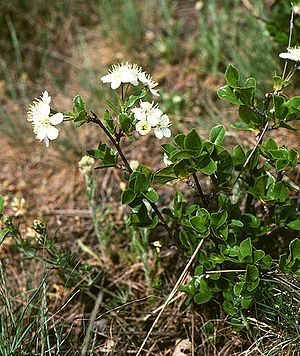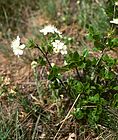Note: This is a project under development. The articles on this wiki are just being initiated and broadly incomplete. You can Help creating new pages.
Difference between revisions of "Prunus fruticosa - Mongolian cherry"
(→Common names) |
(→Uses) |
||
| Line 4: | Line 4: | ||
==Uses== | ==Uses== | ||
| − | {{Uses| | + | {{Uses|Indigestion}}, {{Uses|arthritis}}, {{Uses|heart diseases}}, {{Uses|anaemia}}, {{Uses|hair loss}}, {{Uses|Blotches}}, {{Uses|Pimples}}, {{Uses|Diarrhea}}, {{Uses|Sore throats}} |
==Parts Used== | ==Parts Used== | ||
Revision as of 17:22, 31 May 2018
Prunus fruticosa is the European dwarf cherry is a deciduous shrub. It is also called ground cherry and European ground cherry, but is not to be confused with plants in the distinct "Groundcherry" genus of Physalis.
Contents
- 1 Uses
- 2 Parts Used
- 3 Chemical Composition
- 4 Common names
- 5 Properties
- 6 Habit
- 7 Identification
- 8 List of Ayurvedic medicine in which the herb is used
- 9 Where to get the saplings
- 10 Mode of Propagation
- 11 How to plant/cultivate
- 12 Commonly seen growing in areas
- 13 Photo Gallery
- 14 References
- 15 External Links
Uses
Indigestion, arthritis, heart diseases, anaemia, hair loss, Blotches, Pimples, Diarrhea, Sore throats
Parts Used
Chemical Composition
Four sugars (sucrose, glucose, fructose and sorbitol) and four organic acids (malic, citric, shikimic, and fumaric acid)[1]
Common names
| Language | Common name |
|---|---|
| Kannada | |
| Hindi | |
| Malayalam | |
| Tamil | |
| Telugu | |
| Marathi | NA |
| Gujarathi | NA |
| Punjabi | NA |
| Kashmiri | NA |
| Sanskrit | |
| English | Mongolian cherry |
Properties
Reference: Dravya - Substance, Rasa - Taste, Guna - Qualities, Veerya - Potency, Vipaka - Post-digesion effect, Karma - Pharmacological activity, Prabhava - Therepeutics.
Dravya
Rasa
Tikta (Bitter), Kashaya (Astringent)
Guna
Laghu (Light), Ruksha (Dry), Tikshna (Sharp)
Veerya
Ushna (Hot)
Vipaka
Katu (Pungent)
Karma
Kapha, Vata
Prabhava
Habit
Identification
Leaf
| Kind | Shape | Feature |
|---|---|---|
| Simple | ovate-elliptical | Leaf Margin is Crenate-serrulate |
Flower
| Type | Size | Color and composition | Stamen | More information |
|---|---|---|---|---|
| Unisexual | 2-4cm long | White | 5-20 | Flower Type is 2 or 4 flowers in sessile umbels, with leafy bracts |
Fruit
| Type | Size | Mass | Appearance | Seeds | More information |
|---|---|---|---|---|---|
| Cherry | 2-4cm | Fruit Type is Cherry-shaped fruit, globose | Fruit Color is Dark red | {{{6}}} |
Other features
List of Ayurvedic medicine in which the herb is used
- Vishatinduka Taila as root juice extract
Where to get the saplings
Mode of Propagation
How to plant/cultivate
Thrives in a well-drained moisture-retentive loamy soil, growing well on limestone[3]
Commonly seen growing in areas
Thickets and dry grassland, Forest-steppes and steppe zone, broad-leaved forest margins.
Photo Gallery
References
External Links
- Ayurvedic Herbs known to be helpful to treat Indigestion
- Ayurvedic Herbs known to be helpful to treat arthritis
- Ayurvedic Herbs known to be helpful to treat heart diseases
- Ayurvedic Herbs known to be helpful to treat anaemia
- Ayurvedic Herbs known to be helpful to treat hair loss
- Ayurvedic Herbs known to be helpful to treat Blotches
- Ayurvedic Herbs known to be helpful to treat Pimples
- Ayurvedic Herbs known to be helpful to treat Diarrhea
- Ayurvedic Herbs known to be helpful to treat Sore throats
- Herbs with Fruits used in medicine
- Herbs with Seeds used in medicine
- Herbs with common name in English
- Habit - Herb
- Index of Plants which can be propagated by Seeds
- Index of Plants which can be propagated by Cuttings
- Herbs that are commonly seen in the region of Thickets and dry grassland
- Herbs that are commonly seen in the region of Forest-steppes and steppe zone
- Herbs that are commonly seen in the region of broad-leaved forest margins
- Herbs








